Have you ever wanted to create fibre art sculptures but wondered how to shape them into self-supporting objects?
Meet textile artist Meghan Rowswell who creates large organic fibre sculptures, alien and triffid-like, inspired by nature. Achieving a BA in Art History at Hastings College in 2009, Meghan has exhibited in galleries and art spaces across the United States. In 2014, while living in Japan, she achieved the title of Fifth Level Instructor at the Ohara School of Ikebana. Using this knowledge of Japanese flower arranging and design she works predominantly with fabrics, aiming to restore their vitality and substance through arrangement, layering and creating structure, to bring her sculptures to life. Meghan’s eccentric large-scale textile structures look like they have come from another world.
Meghan has completed a residency at Art Farm Nebraska and was an Artist INC Kansas City fellow. Also, she is a member of The PolyArtery Collective, a four-artist group that received the Inspiration Grant from ArtsKC and the Interpretive Grant from Freedom’s Frontier National Heritage Area. The PolyArtery Collective were semi-finalists for the Rocket Grant in 2017 for their immersive art experience, “Weaving the River.” Meghan’s work has been published in two books and in the media and has been featured on the television programme “Mid Missouri Art Talk.” She is the current Blog Content Director for the Military Spouse Fine Artist Network.
In this interview explore Meghan’s exaggerated and fantasy-inspired textile sculptures. She shares how she first got into sewing and embroidery work and quickly became hooked on creating oversized pieces, aiming to get her fibre artwork away from the wall. Discover how her chosen textiles give rise to her designs and how she tackles the challenge of getting her textile shapes into a self-supporting form, making them appear almost as other-worldly beings.
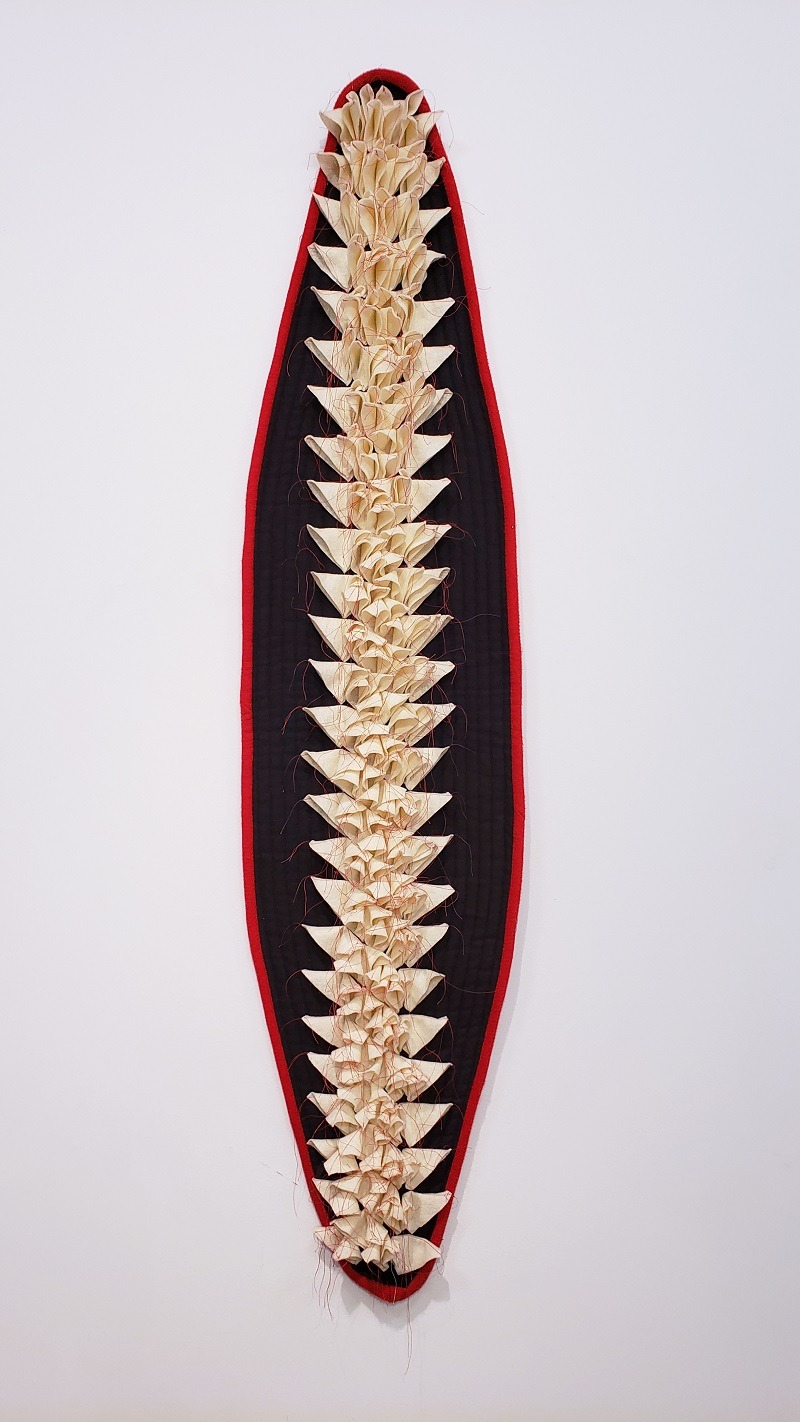
Sculptures coming alive
TextileArtist.org: What initially attracted you to textiles as a medium? How was your imagination captured?
Meghan Rowswell: My mother and grandmother both sewed, knitted, and quilted when I was young. You could say textiles were integral to my upbringing. I learned most of my textile techniques, like quilting, knitting, garment construction, and embroidery, while part of an agricultural and home economics-based children’s group. I have a clear memory of falling in love with embroidery aged twelve. I was attracted to the social aspect of sitting in a group of women, talking and stitching. The only drawback was that I did not want to follow the patterns! I kept getting bored and creating my own embellishments.
I studied Art History at college with a minor in Studio. Textile sculpture came alive to me in a large sculpture class during my junior year, when our project was to create a fifteen-foot inflatable sculpture and sew a pattern moquette. My team created a twenty-foot milk jug that could not inflate until the whole class stood inside it to weigh it down. I was hooked!
Ever since I have preferred to exaggerate textile techniques to create sculptures and installations. I love the challenge of giving fabric a form and juxtaposing textures.
Spine was my first attempt to create texture on a quilted background and everything else since has been an attempt to get my work further away from the wall.
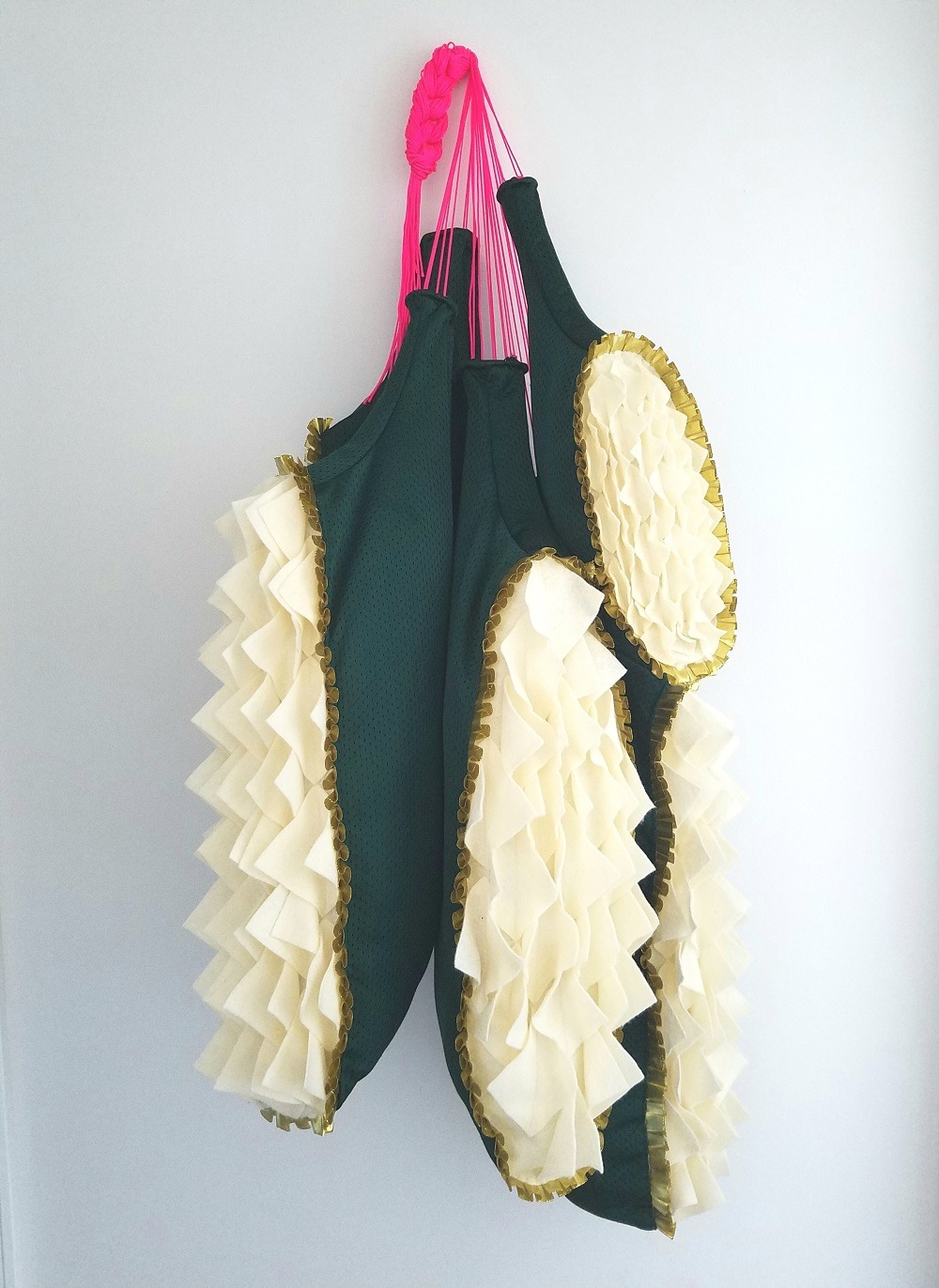
What or who were your early influences and how has your life/upbringing influenced your work?
My grandmother, an avid gardener and birdwatcher, was a huge influence on me when I was young. Her lessons on plant identification and gardening have always stuck with me.
Originally, I went to Cornell University to study plant science, but when I realised I could not also take art classes on my scholarship, I changed schools and programmes for a more interdisciplinary approach.
My grandmother’s wildflower bouquets on the table inspired me to learn Ikebana, Japanese flower arranging, and then to become a Master Gardener. All this study into plant structures and Japanese design aesthetics inform the work that I am doing today.
Growing up, my father was an agricultural mechanic and car racing fan. Both of my brothers have gone on to work as mechanics and foremen in the oil fields. This engineering influence has contributed to my love of brightly coloured construction materials and lots of metal components in my work.
I love finding beauty in utilitarian objects. And combining the mechanical and botanical to create a post-apocalyptic future, with added sequins!
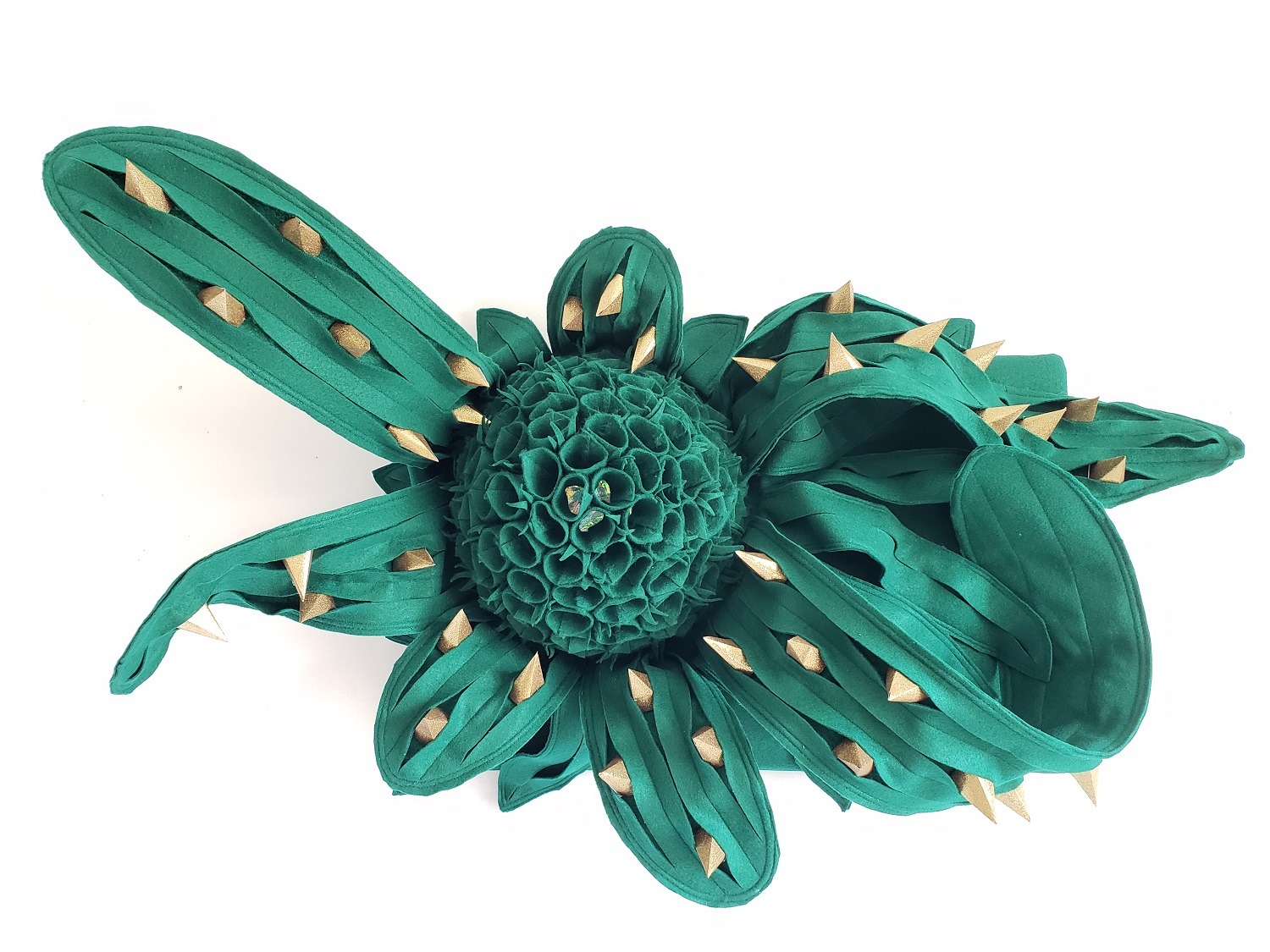
What was your route to becoming an artist?
After college I got a job working as a librarian, then rented a studio and just kept on making work. Soon after that, I met my husband and he joined the military. We had a mutually-accepted marriage contract that he would work in his chosen career and I would make art. Though being a military spouse has its challenges, the contract remains agreeable to us both.
Our first base was in northern Japan. I became pregnant a month after our plane landed. It was such a crazy experience being in a place where you cannot even read the signage, being pregnant and finding yourself completely cut off from the Western art world.
I decided to immerse myself, learning everything I could, utilising this amazing place to teach and inspire me. I studied everything I could about Japanese textiles and Ikebana during my daughter’s naps. I taught crafting classes and sold bags on the military base that I had constructed from Japanese fabrics.
When we moved back to the US things really started taking off for my art. My daughter started kindergarten and suddenly I found I had time to make a body of work and start applying for opportunities.
I turned the master bedroom into my studio. My friends think I am nuts, but do you really need a giant room if all you are going to do is sleep? Now I get to start my day sitting in my favourite studio chair, working on something ridiculous yet fantastical.
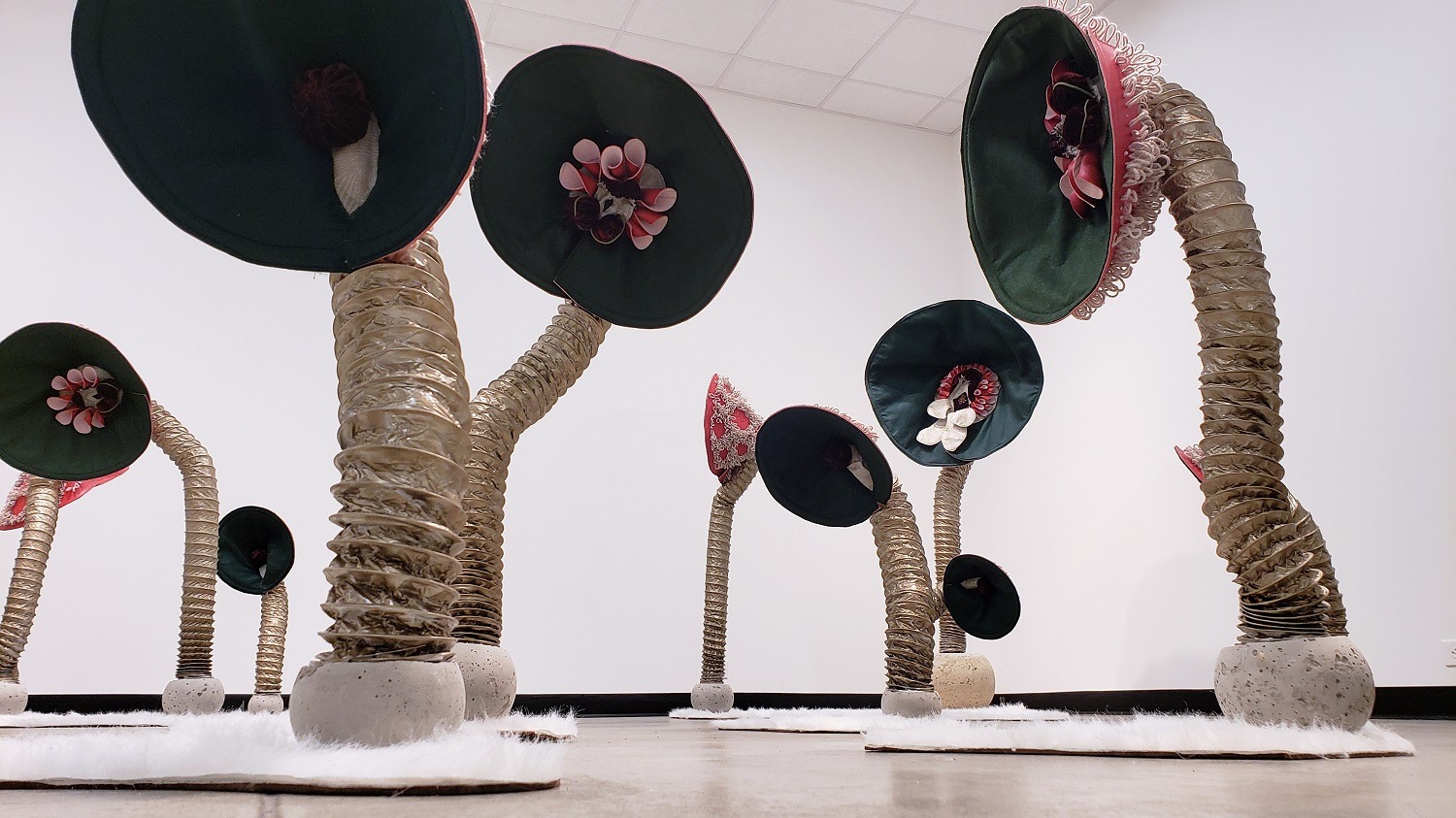
Defying gravity
Tell us about your process from conception to creation
Usually, my sculptures start with the fabric. I find a few textures and colours that I really want to play with and then I decide what textile techniques I want to employ.
With The Stalks I became obsessed with rug hooking car upholstery because I found a rug-hooking tool at the thrift store. I wanted to see the juxtaposition of the woolly yarn loops next to the smooth vinyl and was pleased with the result.
Fabric inspiration aside, it is all about form and composition. This becomes the tricky bit where gravity and my own technical know-how collide.
With the rug hooking for The Stalks, I wanted to replicate the flower bell of Ireland, which hosts a bunch of bells on a central stalk. It was difficult for me to construct a single post so I broke it up into smaller pieces and create a floor installation. I quickly realized, however, that the bells were so heavy I needed a good solid base for them so that they did not tip over.
That is when I started pouring concrete. Things were still a bit tipsy because the concrete bases were not always big enough or flat enough on the bottom. Enter the faux fur-covered Masonite hardboard to save the day. Art evolution dictated by necessity. It all makes you feel like Alice in a craft store basement wonderland!
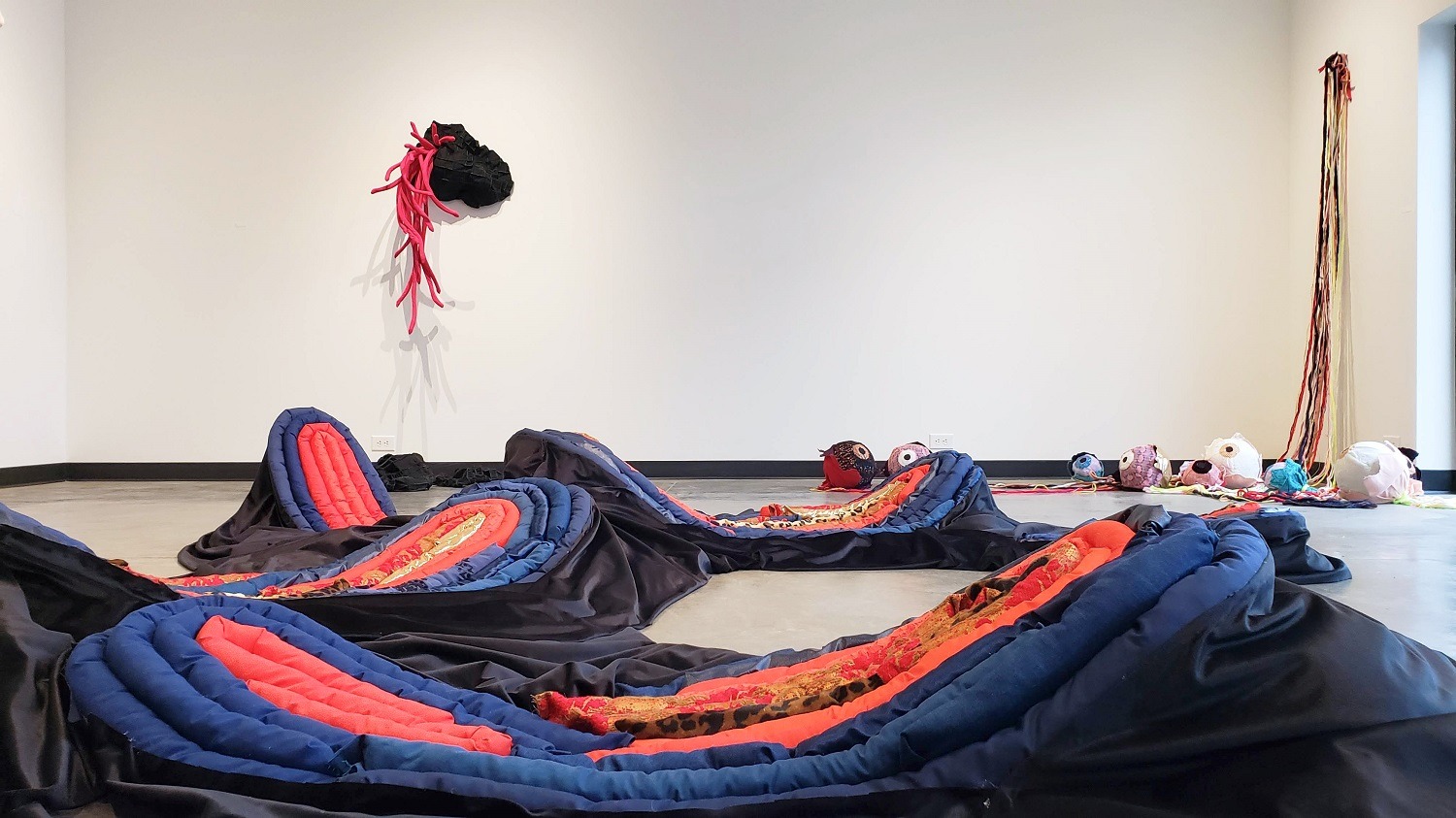
Tell us a bit about your chosen techniques and how you use them
These days I do a lot of pattern cutting, sewing and stuffing. It is really pleasurable to figure out the right pattern to get a certain shape.
Discovering when to employ the repetition of thread to create order or the entanglement of thread to create chaos is immensely satisfying, too.
A current obsession of mine is finding fabric stiffeners that do not affect the texture of the fabric. And smocking! I am desperately in love with all the interesting ways to smock or pleat fabric. I am having a blast creating pin tucks.
I adore any fabric preparations that help me achieve the undulating organic simplicity and refinement of form that haunts me in my dreams.
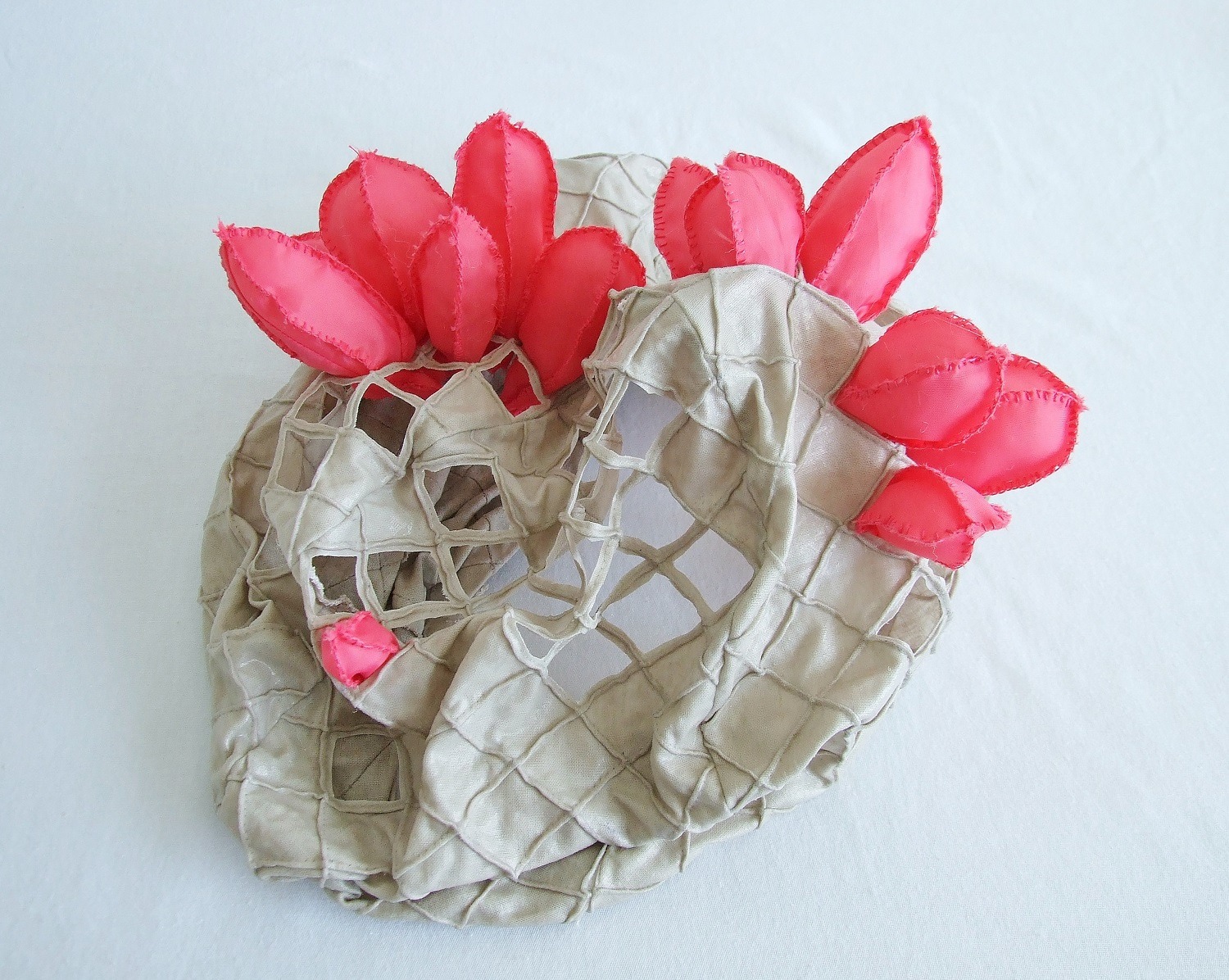
What currently inspires you?
What I love about art is that no topic is taboo and inspiration has no limits. At the moment I am mesmerized by slug sex and I am trying to put together a collection of works based on sexual reproduction in plants and animals.
I’ve just bought an iridescent tablecloth from Walmart while birthday shopping for my daughter that I am excited about using in my work.
I read avidly for inspiration. Currently, I am reading a biography of Alexander McQueen and John Galliano called Gods and Kings: The Rise and Fall of Alexander McQueen and John Galliano . I cannot put it down! I am also reading John Dryer’s White about white peoples’ representations of themselves in art and media, which I am finding brilliant and very thought-provoking.
Recently I learned about an epiphyte organism from Papua New Guinea. I have now become a little bit obsessed with epiphytes and it has rekindled my love of Papua New Guinean art.
How will this all come together? What will I start making? I do not know. What I do know is that something amazing lurks among all these intriguing bits of research.
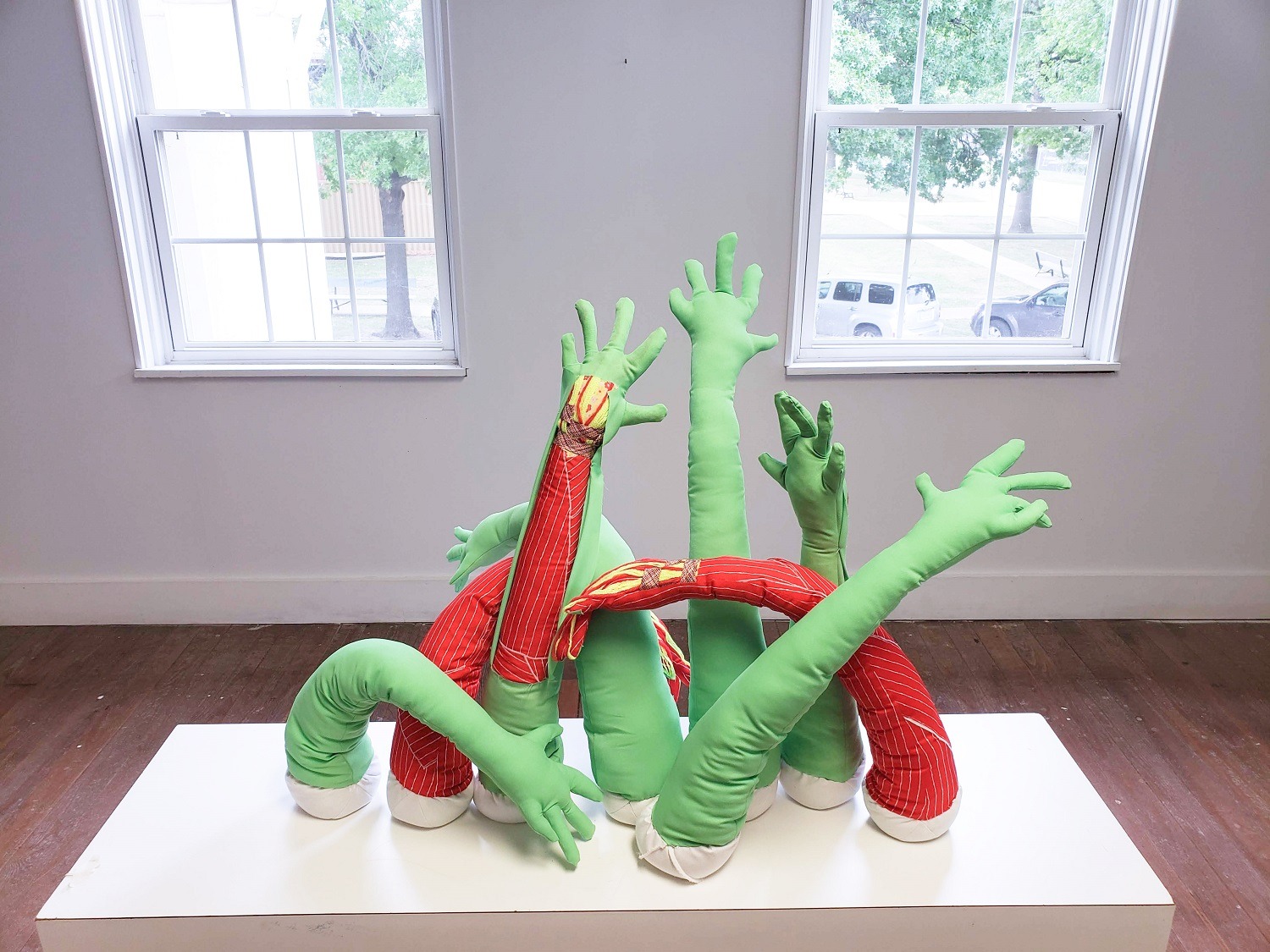
Fantastical creations inspired by nature
Tell us about a piece of your work that holds particularly fond memories and why?
Handsy is a piece that was a lot of fun to make. The show was called “Fondle Friendly,” and the concept was that all the work in the show could be picked up and arranged by the audience. All the work in this particular show was based on medical dissection illustrations.
People love to touch textile work, even in a gallery context, and so I decided to just give in to their impulses.
I wanted Handsy to be a grouping of arms that could be posed at different angles, but it took me a while to find a workable solution that was not static or fixed. I filled the bases with sand and stuffed them pretty tight and the arms came alive in a pleasing result. Two of the arms are skinned with muscles and ligaments showing and another two arms are whole. I then decided to sew two with the skin and muscles together. I flipped them, stuffed them, and had the best time filming myself cutting open the skin to reveal all that tendon and muscle work.
It was very cathartic and a little grotesque but it is a technique I would like to try again.
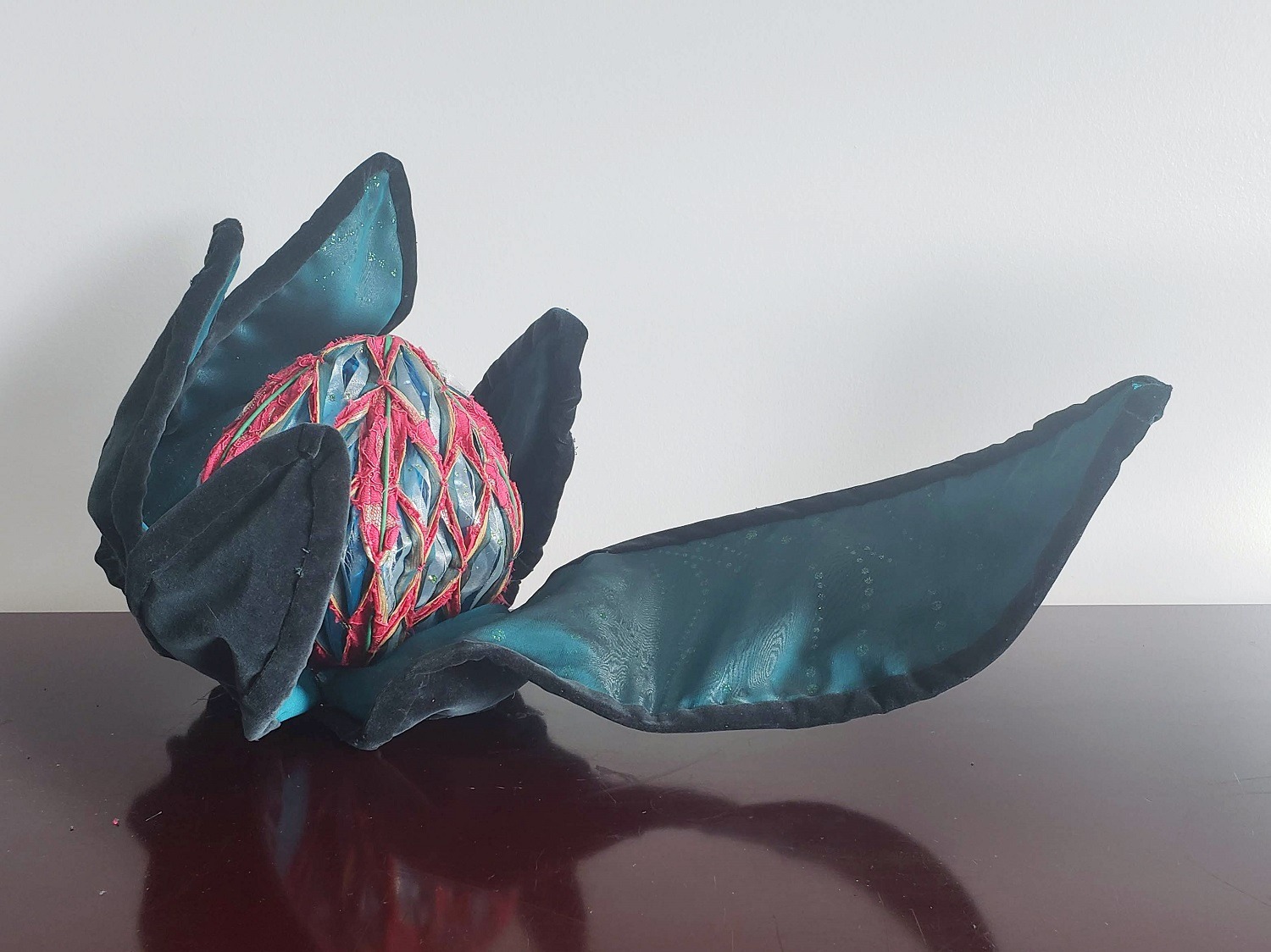
How has your work developed since you began and how do you see it evolving in the future?
My creations are getting bigger and bolder. My execution is better. Refining my colour palette and textile choices has been especially important to me of late.
I like to make sure the fabrics are telling a story and evoking emotion.
My work has definitely become brighter, as I play with sparkle and transparency. I am studying composition to further nail down contrast and movement in space.
I am also trying to draw more so that my compositions are more pre-planned. Working in a different way can be unnerving, but it is important to keep challenging yourself.
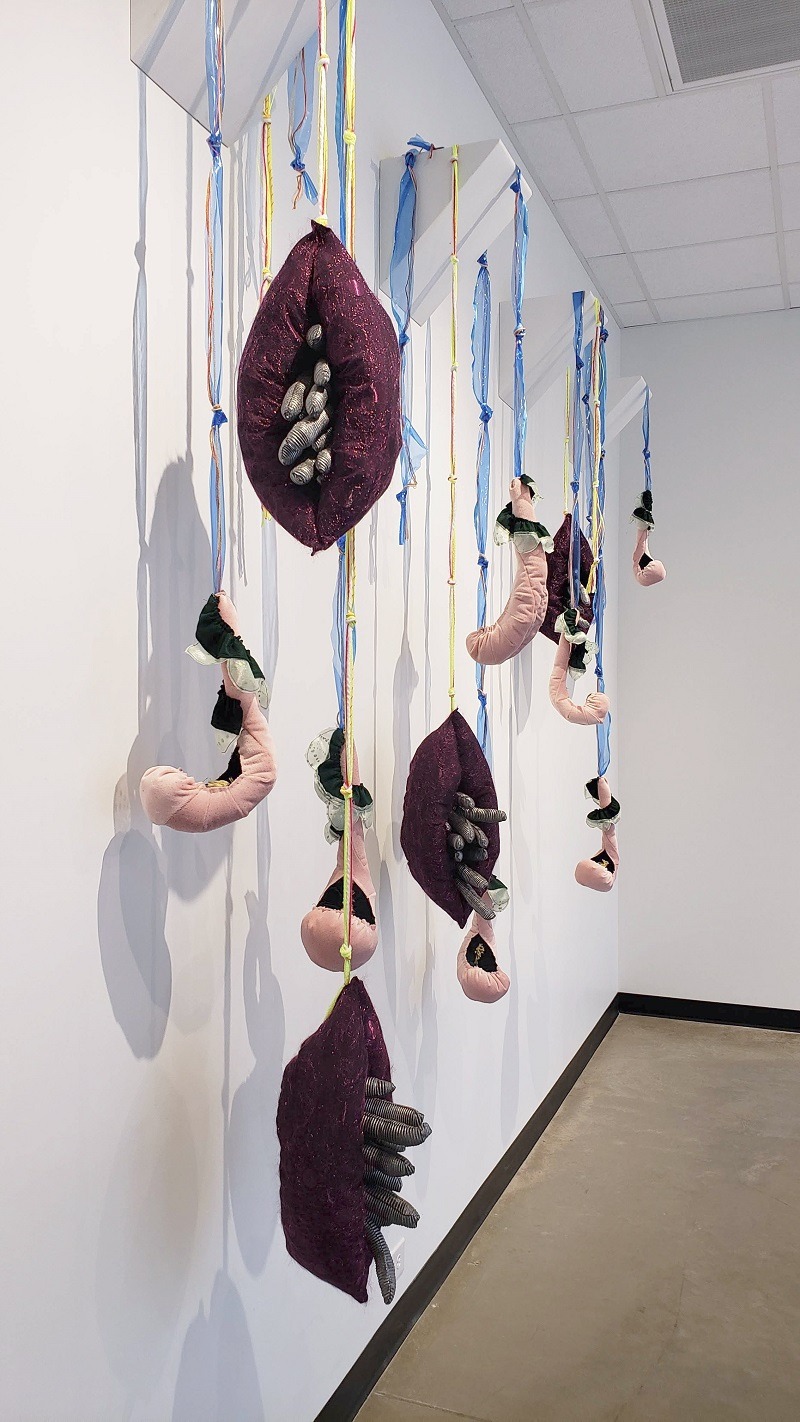
What advice would you give to an aspiring textile artist?
Read everything. Listen to podcasts while you work. Get outside your comfort zone and study genres or authors you would never normally seek out or pick up.
Pull inspiration from everything around you. See as much art as you can. Put your phone down, go for long walks and stare at things.
I find the best ideas come when you give yourself a chance to stop for a moment and breathe.
Find yourself some fibre! Join your local guild and actually show up. Attend gallery openings. It is the relationships you create with other creatives that will fuel your practice through the good times and the bad. We are all in this together and you never know where the best ideas will come from.
For more information visit www.MadMegh.com
What do you think of Meghan’s out-of-this-world 3D creations? Let us know by commenting below.
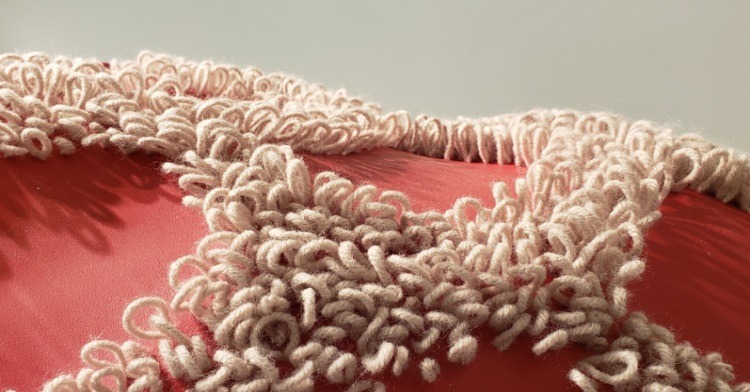

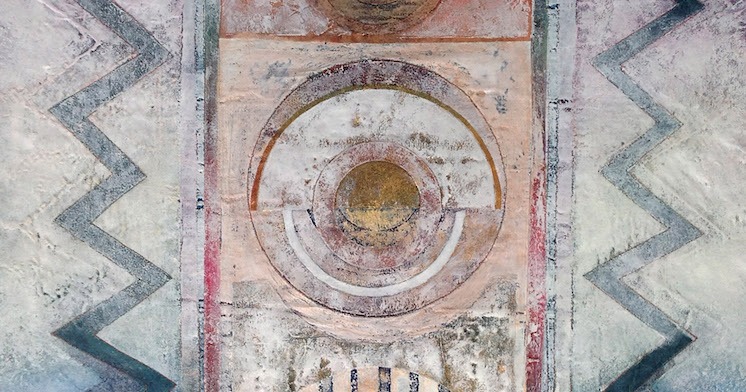
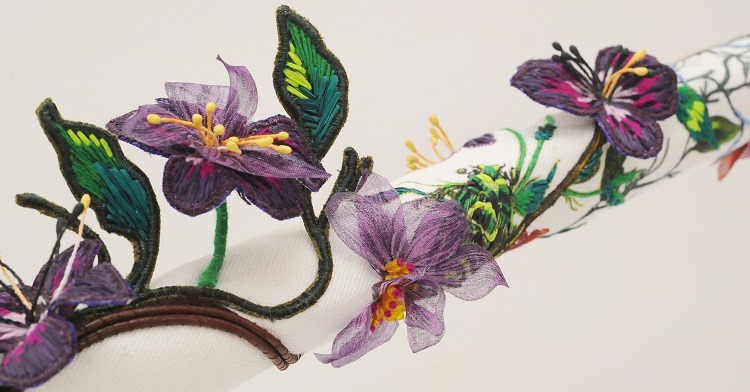
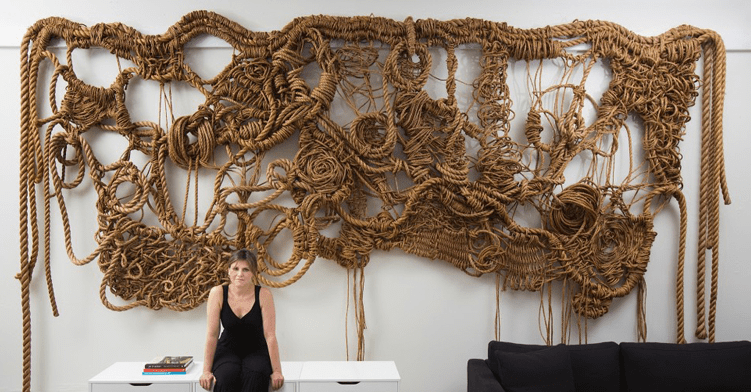
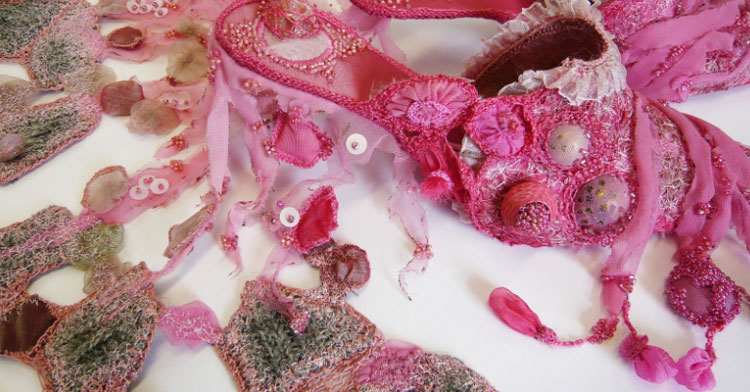
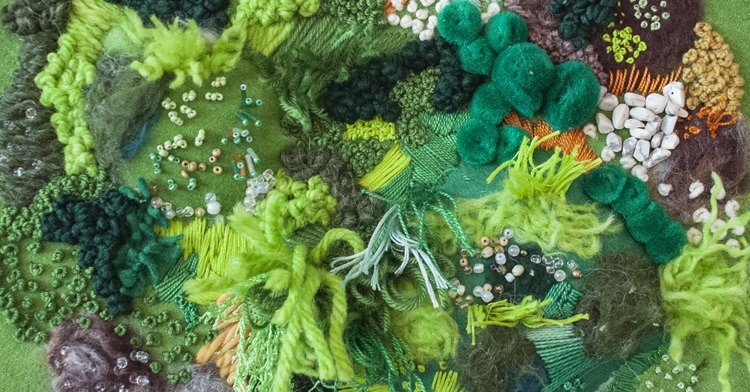
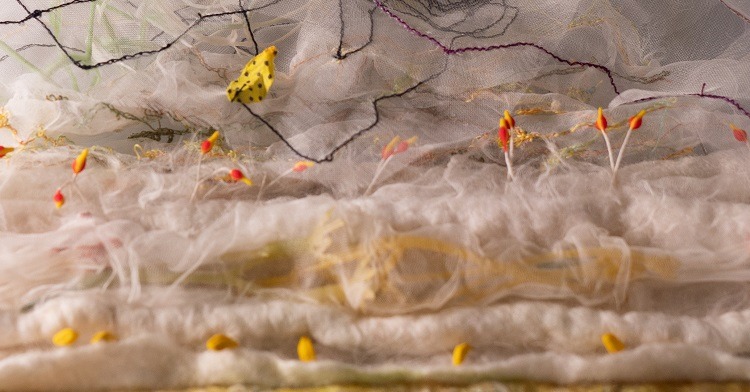
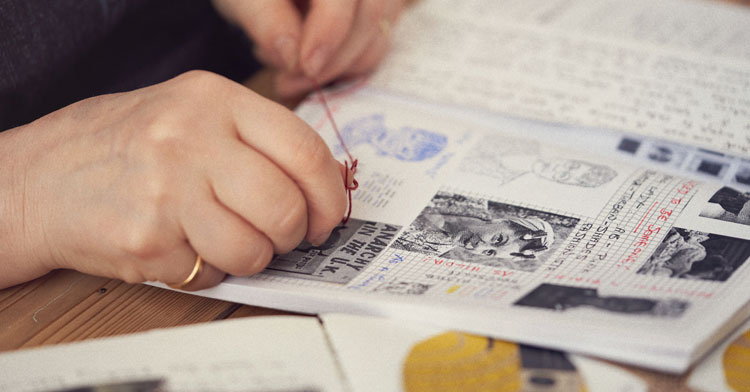
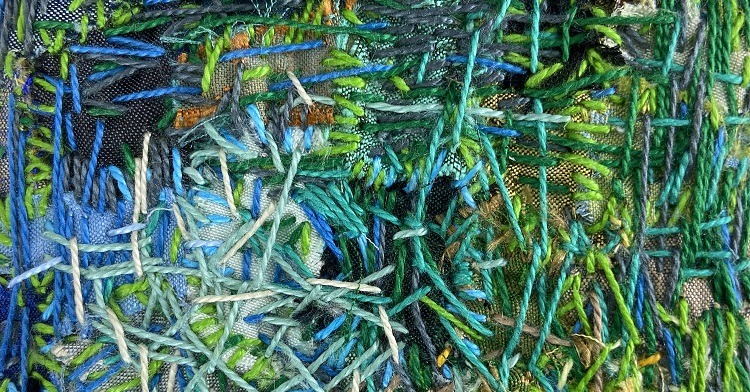
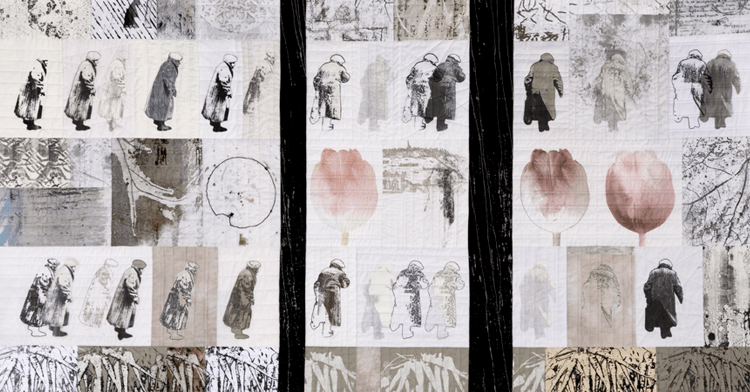
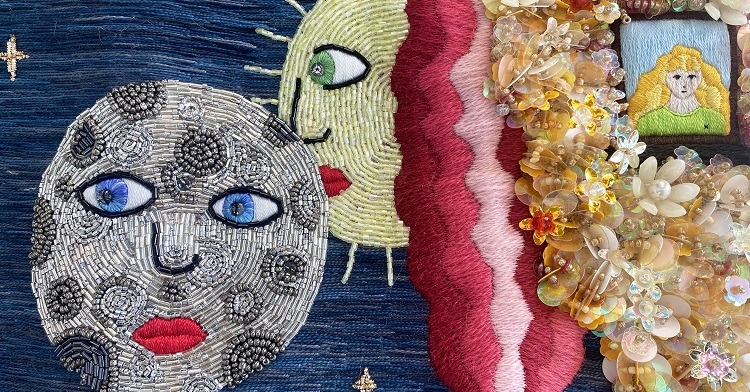
9 comments
Deborah Haviland
This artist’s work is so exciting! I wonder, though, if the article should be updated. When I followed the link to view more of their work I was confused at first to see the work of Korey Rowswell. It seems that the artist has changed their name and pronouns. Thanks so much for sharing such amazing work!
Elizabeth Richie
Meghan’s textile sculptures are SO inspiring. I love her approach to her work and her great enthusiasm to explore different techniques, art disciplines and nature itself. I also love the scale of her hanging sculptures. Thank you!
rose
what interesting and unnerving installations! they have out of this world almost nightmarish quality which is the opposite of the perceived idea of cute,cuddly and fluffy and oh so safe textile pieces. i am sure your future pieces are even more innovative and wonderful.
Margot
Fabulous interview . Such energy and vision !
Mariani
Absolutely fantastic, awe inspiring,outside the box.
Really words are not enough to express these over the top creations.
So much enjoyed this post.Thank you very much.
Mariani
Rae Frost
It is a beuatiful and exotic work. Love it
Jamie Root
Love the way Meghan finds the intersection of her current interests to inspire her pieces.
Jill N Smith
Love this!
Lexy Cann
Wow. This was such an inspiring interview! Even though not all the sculptures were to my liking, I absolutely loved her process and her insistance of following her passion, putting her priorities in order ( her choice of school and use of the master bedroom), and utilizing her inner and outer world to find inspiration and expertise. She definitely makes me want to live as large as possible ❣️